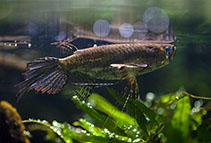| Family: |
Pantodontidae (Freshwater Butterflyfish) |
| Max. size: |
11.9 cm TL (male/unsexed) |
| Environment: |
pelagic; freshwater, potamodromous |
| Distribution: |
West and Central Africa: Nigeria, Lake Chad, Cameroon, Ogowe basin, Congo basin and upper Zambezi River (Ref. 2921, Ref. 3515). Eastern distribution limit seems to be the Ouémé River in Benin (Ref. 1989, Ref. 3019), although it is also reported from the Jong River in Sierra Leone (Ref. 2921). |
| Diagnosis: |
Dorsal spines (total): 0-0; Dorsal soft rays (total): 6-6; Anal spines: 0-0; Anal soft rays: 9-15. Compressed body, flattened on the dorsal side and head, careened on the ventral side behind the pelvic fins (Ref. 2921, Ref. 13851). Large mouth, with numerous teeth and a prominent lower jaw (Ref. 2921), upwardly directed (Ref. 3054, Ref. 42873). Short dorsal fin placed very posterior on the back (Ref. 2921), inserted behind the longer anal fin (Ref. 3054, Ref. 13851). Large development of the pectoral fins (Ref. 2921, Ref. 3054), enlarged and wing-like (Ref. 42873). Very advanced position of the pelvic fins, with 4 elongated, filamentous rays (Ref. 2921, Ref. 3054). The caudal fin is long, pointed and rather ragged, with the two centre rays the longest (Ref. 13851). Large cycloid scales (Ref. 2921), subcircular, with rounded but evident laterobasal angles (Ref. 53264): 26-30 lateral line scales, 21-26 predorsal scales (Ref. 52030, Ref. 52046). Extremely brilliant colored (Ref. 2921): dorsal side of the body olive-colored, ventral side silvery yellow amplified with carmine; sometimes with darker transversal bands on the back (Ref. 2921, Ref. 3032). The fins are vivid pink-colored with small brown-violet spots, forming transversal bands on the pectoral fins, and tinted with violet on the inside and extremities (Ref. 2921). |
| Biology: |
Pantodon buchholzi is a creature from calm waters (Ref. 51626). It lives in swamps, creeks and backwaters (Ref. 31256), and inhabits the calmer parts of rivers (Ref. 41580), where it can be seen on the surface waters (Ref. 4910). They are capable to jump out of the water, to search for insects or to escape from predators (Ref. 2921). It is not a glider, but a ballistic jumper (Ref. 52282), with a tremendous jumping power (Ref. 31256). It is an exophageous insectivore, feeding on terrestrial insects and aquatic larvae and nymphs of insects (Ref. 41580). It also feeds on crustaceans and fish (Ref. 7020). Introduced in 1905 to European aquarists (Ref. 51626, Ref. 53207). Pantodon buchholzi is a favorite fish for aquarists; in the aquarium it can rest with the top of the head and the large pectoral fins touching the surface, while the long rays of the pelvic fin hang down perpendicularly, forming a tempting morsel for other aggressive fish in the same tank, and therefore it should be stocked together with only bottom dwellers (Ref. 13851). Observed maximum length of 15.0 cm TL in aquarium (Ref. 2921, Ref. 3515). |
| IUCN Red List Status: |
Least Concern (LC); Date assessed: 05 June 2019 Ref. (130435)
|
| Threat to humans: |
harmless |
Source and more info: www.fishbase.org. For personal, classroom, and other internal use only. Not for publication.

